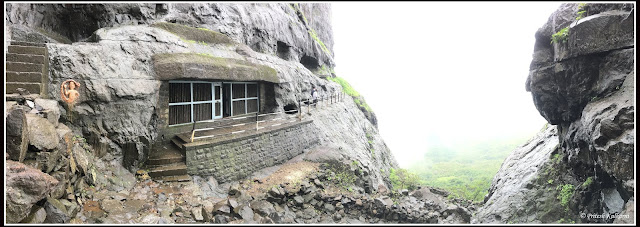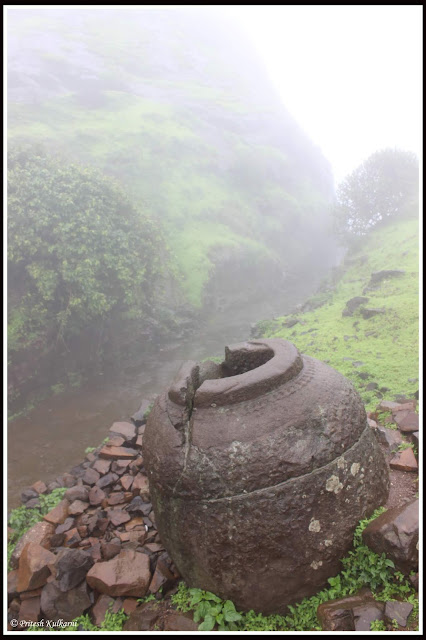Monsoon was on peak in Maharashtra and we don’t want to miss the opportunity for the trek. Wanted to avoid crowded and famous trek hence we decided to Visit Chavan fort from Junnar area along with a quick visit to Naneghat.
Trekkers for this trek were I, Himanshu and Aditya.
 |
| Chavand Fort |
About Chavan and Naneghat:
Chavand fort is in Junnar Taluka and around 15-6km from Junnar town. Fort was built during Satvaahan era. Fort Name was Prasannagad under the rule of Shivaji Maharaj. Chavandwadi is the Base village of the fort.
Naneghat is the mountain pass which was used as a trade route between Konkan (Mumbai Coastal) and ancient town of Junnar. It is around 30km from Junnar town. Mountain pass was built by Satvaahan empire and they carved cave at the entrance which has Brahmi script carved on the wall.
To reach Chavand from Pune is Pune - Kasarwadi Phata - Pune-Nashik Highway - Take a left at Narayangaon - Junnar - Take the straight road from Shivaji statue - Chavandwadi.
The same road goes to Naneghat and distance from Chavan is around 15km.
GPS Location
Chavand Fort: 19.238097, 73.745905
Naneghat: 19.291958, 73.675661
7 July 2018: Pune - Chavand - Naneghat:
Wari procession was planned in Pune city so to avoid the traffic, we decided to leave Pune before 5AM. We woke up at 4 and left Pune by 4:45AM. Journey on Nashik Highway was pretty smooth without any traffic. We reached by 6:30AM and had quick breakfast in Junnar town. We moved ahead for base village Chavandwadi. It was cloudy weather with some rain showers. You can view massive but beautiful Chavand fort and it’s rock patch from base village. There is enough space near the village school to park your vehicle.
 |
| Chavandwadi village |
We begin our trek. Chavand fort is small and it hardly takes 30-45 min to climb it. Steps were built by local authorities till the rock patch and then steps carved in rocks takes you to the entrance gate. Climbing the steep steps can make you a little tired. Each step is bigger than a regular step. Sometimes it is about a knee high. After climbing the steps, we reached the start point of the rock patch. This part of a trek uphill was indeed pretty interesting. There are few Steps cut in the rock patch. Those are more like small Footholds than the steps. Safely railing and rope with the bolt are mounted on the rock patch for trekkers safety.
 |
| Rock patch at Chavand Fort |
We reached the entrance gate after the Short climb. The entrance gate is in good condition and you can see Ganesh Idol on the top of the Entrance gate frame. It indicates that entrance is built/re-Built during the Maratha empire. There are two ways to enter in the fort, the Left route is parallel to fort wall but not in proper shape to explore. Take the right route to go to the top of Fort.
 |
| Entrance Gate of Chavand Fort |
After a few step climb, you can see many ruined fortification. It indicates that this fort was used as one of the main forts and not a watchtower. You can see trenches and Stone-pot in few ruined house. From this ruined place, one route goes to the top of the hill. Temple of goddess Chamunda is situated on the hill. Goddess belongs to Bengal/Bihar region. During Satvaahan era, Naneghat was built and it was trading route from coastal to central India. Trading People from Bihar or from Bengal brought the Goddess idol which was established on the fort. Fort name Chavand also came because of Goddess Chamunda. View of Sahyadri from this point is breathtaking. You can see Hadsar, Shivneri, Jeevdhan, and Naneghat fort. We came down to Ruined place after Darshan.
 |
| Temple at the top |
We went ahead to explore the fort. We saw the ruined temple. Temple is not in condition but you can see Shivlinga which indicates that the temple belonged to Lord Shiva. There is a water trench in front of the ruined temple. Some carved broken stones and broken Nandi can be seen in the ruined temple area.
 |
| Shiva Temple with broken Nandi and Lake |
 |
| Ruined Shivliinga inside Shiva Temple |
we moved ahead to explore the fort area. We took right side route after a few meter walks keeping ruined temple on the right side. There are 7 water tanks aligned along each other. It is known as Saptamatrika and name of water tanks given as Brahmi, Maheshwari, Kaumari, Vaishnavi, Varahi, Indrayani & Chamunda which are powerful goddess names. We saw Human-made caves on the North-East side of Fort. There are around 5-6 caves. Local believes that they belonged to Satvaahan ear. Considering the construction of caves, they look like built during Nizam or Memperorempiror. It is mainly used by soldiers and to keep watch on the area. You can see a beautiful view of Manikdoh Dam.
 |
| 7 Water trenches on Chavand Fort |
 |
| Saptamatrika water trenches |
 |
| Man-made Caves |
 |
| Manikdoh Dam view |
After spending more than an hour, we left the fort. We climbed down quickly and went to our next destination which was Naneghat. Naneghat is the mountain pass which was used as a trade route between Konkan (Mumbai Coastal) and ancient town of Junnar. During the Satvahan era, Pratishtan (Now Paithan) was the capital whereas Jirnnagar (Now Junnar), Tagar (Ter) and Nashik were important cities. The trading route was required for traders from Coastal ports to Satvahan cities and hence Naneghat was built.
 |
| Naneghat |
 |
| Naneghat |
The road is available till the start point of Naneghat. As this mountain pass was used as a trade route, tollbooth was placed to collect toll (Satvahan's currency: Karshapan coins). You can see a large stone pot to collect tolls from traders. Few meters ahead, we saw a Large cave. Cave has Brahmi script carved on the cave wall. This script consists of Numeric information, detail information on Satvahan kings and much more other information as well. You can see few water trenches outside Cave. Entire Trade route built by cutting mountain stone can be seen from here.
 |
| Man-made Cave at Naneghat |
 |
| Stone pot to collect Toll at Naneghat |
Trekkers climb up entire Naneghat which is famous trek route. We climbed down a few meters and came back. We also had a quick climb on the mountain which is above Cave. Mountain peak is known as Nana cha Agatha (Uncle's Thumb) due to its Shape. Peak offers you a breathtaking view of Sahyadri.
 |
| Naneghat route |
We returned to Junnar town and had lunch at Multi-spice restaurant. Food was very tasty and service was quick. After lunch, we started our return journey to Pune. We reached home by 9 PM safely ending a pleasurable monsoon trek.
Our Expenses:
- Car Fuel: INR 1500/-
- Toll: INR 51/-
- Breakfast and Coffee at Junnar: INR 185/- for 3 people
- Lunch at Multi-spice: INR 620/- for 3 people (Starter, Soup, 1 veg dish and Rotis)
My Other travel blogs from the nearby area
Shivneri Fort and Malshej Ghat
Narayangad fort and Amba-Ambika caves
Thanks for reading this Travel Blog. Happy travelling.
Pritesh Kulkarni
Pune.















